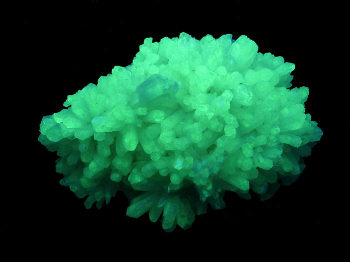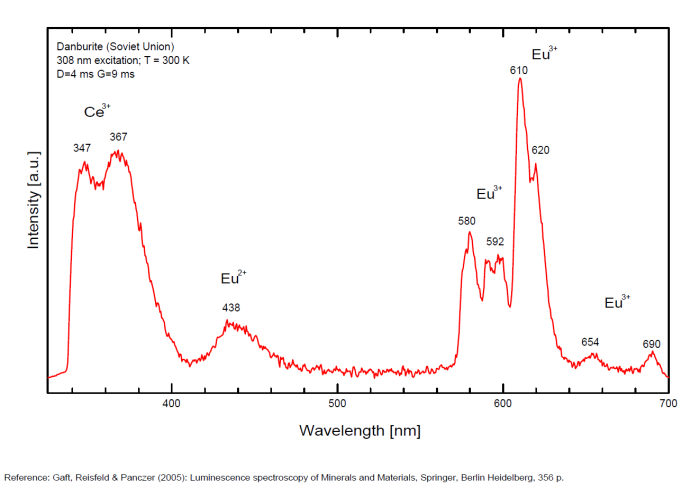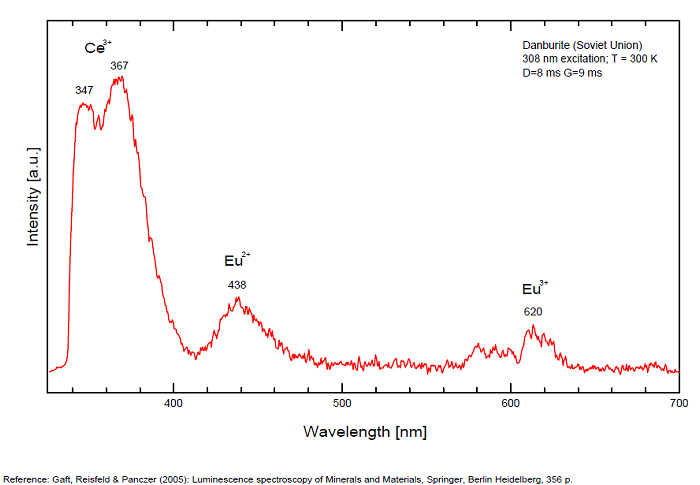Database of luminescent minerals
DANBURITE
Chemical formula: CaB2(SiO4)2
Family: Silicates
Status: IMA-GP
Crystal system : Orthorhombic
Display mineral: NON
Luminescence:
Longwave UV (365nm) colors: |
Blue , Bluish Green , Violet , Violet blue , | ||
Shortwave UV (254nm) colors: |
Blue , Green , Bluish Green , | ||
Intensity SW:Weak | |||
Daylight picture
Shortwave (254nm) picture

DANBURITE under UVSW,
Photo and Copyright: James Hamblen
Site of the author
Used with permission of the author
Do you have a photo of this mineral you would like to see in the gallery? Contact us!
Phosphorescence (in the common sense of the term) observable with the naked eye:
No data
Triboluminescence: OUI
Activator(s) and spectrum:
Activator(s): Eu2+, (UO2)2+ (ion Uranyle) en impureté, Ce3+, Sm3+, Eu3+, Dy3+, Tb3+, Mn2+ , Nd3+, Yb2+,
Peaks in the spectrum (nm):
Ce3+: 346 - 347, 367nm
Eu2+: 437 - 438, 455nm
Yb2+: 535nm
Eu3+: 580, 592, 610 - 611 - 613, 618 - 620, 654, 690nm
(All REE replacing Ca2+)

Spectrum: Michael Gaft, Petah Tikva, Israel. Plot: Institute of Mineralogy, University of Vienna, Austria, with permission of the authors.
Spectrum Galery:



 ...
...Comments on spectrum and activators:
Triboluminescence cited by De Ment (1947). Luminescence centers Eu2+, Yb2+, Ce3+, Dy3+ and Sm3+ characterize steady-state spectra of danburite (Gaft et al. 1979).
Best localities for fluorescence (*):
- Aurora Mine, Charcas Mineral District, Mun. de Charcas, San Luis Potosí, Mexico (bright yellow green or bright violet-blue LW+SW);
- Japan, locality unknown (bright blue LW);
- Mogok Township, Pyin-Oo-Lwin District, Mandalay Division, Burma (bright green-blue LW);
- Hormuz Island, Hormozgan Province, Iran (modest yellow-green SW and purple LW);
(*)The data are not exhaustive and are limited to a few remarkable localities for fluorescence
Bibliographic reference for luminescence:
- The Henkel Glossary of Fluorescent Minerals, Dr. Gerhard Henkel, Published by the FMS, 1989 ,
- Fluorescence: Gems and Minerals Under Ultraviolet Light, Manuel Robbins, 1994, Geoscience Press, ISBN 0-945005-13-X ,
- The World of Fluorescent Minerals, Stuart Schneider, Schiffer Publishing, 2006, ISBN 0-7643-2544-2 ,
- Luminescence Spectroscopy of Minerals and Materials, M. Gaft, R. Reisfeld, G. Panczer, Springer Editor, ISBN: 10 3-540-21918-8 ,
- Luminescent Spectra of Minerals, Boris S. Gorobets and Alexandre A. Rogojine, Moscow, 2002 ,
- Handbook of Fluorescent Gems and Minerals, a practical guide for the gem and mineral collector, Jack de Ment, 1949 ,
Reference for luminescence on the Internet:
Images:
- Charcas, San Luis Potosí, Mexico: http://www.mindat.org/photo-651474.html
Mineralogical reference on the Internet:
 http://www.mindat.org/show.php?name=Danburite
http://www.mindat.org/show.php?name=Danburite
 http://webmineral.com/data/Danburite.shtml
http://webmineral.com/data/Danburite.shtml
Internet Search:
 Image search on 'Google Images'
Image search on 'Google Images'
 Search for documents in all languages on Google
Search for documents in all languages on Google
A request providing no result means only that no such reference exists in the database, but it does not mean that what you are looking for does not exist, just not to our knowledge. If you think you have found an error or omission, please let us know via the contact page being sure to cite the source of information.


